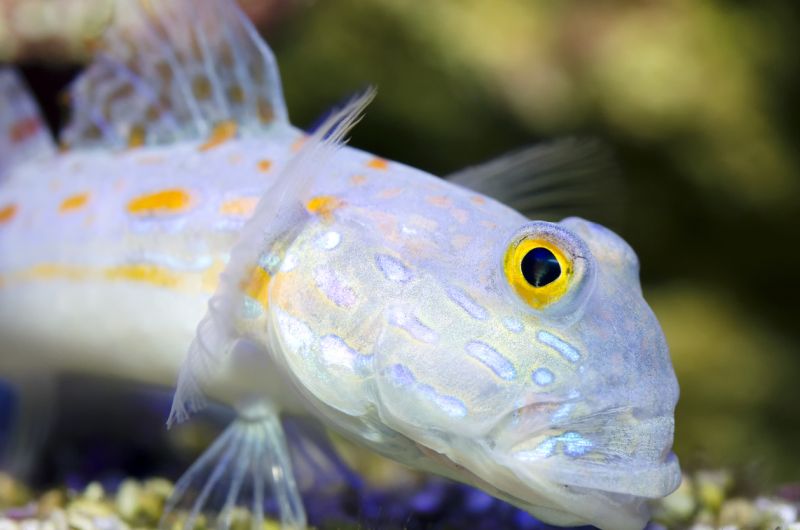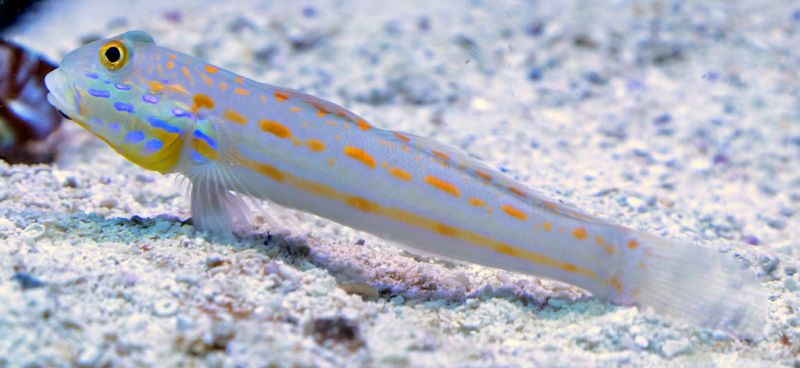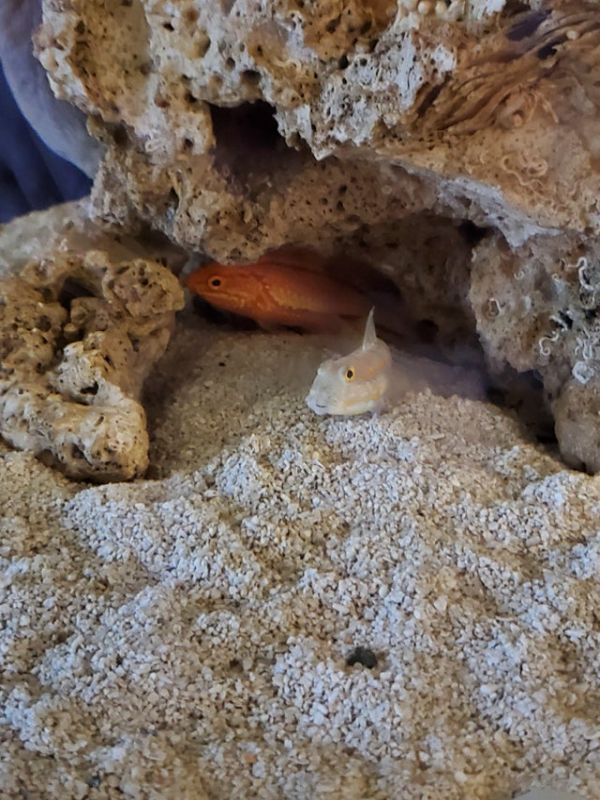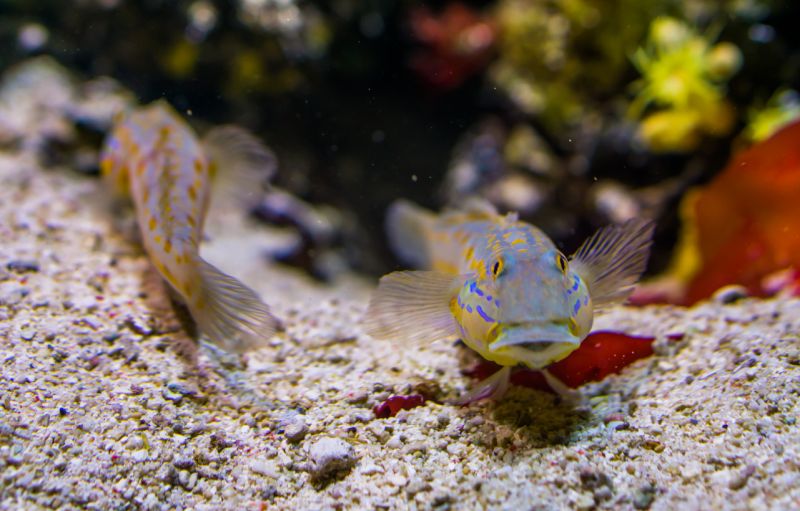Gobies are some of my favorite fish because they are often highly specialized for a particular niche (lifestyle). And the Diamond Goby is one of the best of the breed; an attractive, peaceful, easy to care for fish that provides a unique service for your tank!

Getting to Know the Diamond Goby
Diamond Gobies are found throughout the Indian Ocean and Western Pacific Ocean, with the majority coming from Fiji and other atolls where reef fish collection is common.
They are fairly large for gobies, reaching up to 6 inches in length. However they are entirely peaceful, if occasionally territorial, because they may take a liking to a particular cave or other hiding place.
Diamond Gobies are technically scavengers, sifting through fine sand for bits of food, tiny invertebrates like worms and copepods, and other items that would normally be missed by most fish.
This turning over of the sand helps aerate it and their feeding habits ensure that no leftover food rots, creating ammonia and other waste products.
Their love of continual digging means that they may disrupt your aquascape in unplanned ways. Diamond Gobies may destabilize live rock and coral or even spit sand onto your corals on occasion.
But even reef keepers find them worth the hassle as they will leave a sand bed looking polished and pristine in just a few days!
- Common Names: Diamond Goby
- Scientific Name: Valenciennea puellaris
- Origin: IndoPacific Ocean
- Length: 5-6 inches
- Aquarium Size: 30 gallons
- Temperament: Peaceful; Territorial
- Ease of Care: Easy
Caring for Diamond Gobies
While they have specific feeding and substrate needs, Diamond Gobies are very easy to care for once you know how to provide for them!

Aquarium Size
Diamond Gobies are medium-sized community fish that are fairly active in nature. Since they will grow 5 to 6 inches in length as an adult, you shouldn’t keep one in an aquarium smaller than 30 gallons.
Larger tanks are always better for them because they spend all of their time sifting and digging around in the sand for food. The larger the tank bottom, the more chances they have to find food!
Substrate for Diamond Gobies
Besides feeding, choosing the right substrate for Diamond Gobies is the key to succeeding with these unique fish. They require being kept in an aquarium with a sand bed, the finer the better.
Coral rubble and larger gravel grains are a bad choice for this fish because Diamond Gobies feed by passing mouthfuls of sand and silt through their gills, hunting for bits of food.
Larger gravel grains can cause damage to their lips, mouths, and gills, which can lead to fatal infections. Diamond Gobies are also known to occasionally dig caves to live in, either temporarily or permanently. So always give them a fine sand substrate to live in.
You are also better off using a live sand substrate when keeping these fish. Live sand is sand harvested from the reef that has a full complement of tiny invertebrates and microorganisms inside it.
These little critters help jump-start the cycling process of your aquarium by consuming any organic matter, ammonia, and other metabolic byproducts they come across. They are also the natural food source for your Diamond Goby!
Just be aware that there will never be enough live sand to fully satisfy the appetite of your DIamond Goby unless you have an exceptionally large aquarium.
These fish are too large, hungry, and active, and will eventually deplete the sand of invertebrates to eat. But the bacteria will live on, continuing to keep your water pristine!
Water Conditions
Diamond Gobies are hardy reef dwellers that enjoy the same conditions as most other tropical community fish. Temperatures should remain between 72-78℉ and the specific gravity (salinity) should fall between 1.020-1.025.
While they aren’t especially sensitive to ammonia, nitrites, nor nitrates, they should not be the first fish introduced to a new tank.
You should use hardier fish like Damselfish or Mollies to cycle a new saltwater tank, adding the Diamond Goby later.
Another reason not to add a Diamond Goby to the tank first is because your substrate may not be mature enough for it.
A fresh bag of sand has absolutely no organic matter or microorganisms for the goby to feed on, leaving it frustrated and potentially starving (see below).
Are Diamond Gobies Reef Safe?

Diamond Gobies are occasionally a little problematic for reef keepers.
Their love of sifting through sand can also be a nuisance because as they dig, they can destabilize your live rock or corals that sit directly on the sand.
Diamond Gobies tend to gently filter sand through their gills but they may decide to projectile spit it out, especially if they discover a patch with no food whatsoever.
Sometimes this spit out sand ends up right on top of a coral, which they don’t appreciate.
Diamond Gobies may also kick up sand with their tails, sending a cloud of sand wafting about, potentially drifting onto nearby corals.
Their irritating potential to nearby corals is accidental, though, and many aquarists find that their gobies eventually calm down and stop spitting sand and destabilizing the aquascape once they’ve fully settled in and chosen a home for themselves.
So, Diamond Gobies are reef-safe since they don’t feed on or pick at coral polyps. But they may cause some accidental irritation, depending on the kinds of coral you have and where they are placed in the aquarium.
Feeding Diamond Gobies
Feeding Diamond Gobies is the main challenge they present because these gobies refuse to compete with others for food at the surface.
Diamond Gobies are exclusively bottom-dwelling and prefer scavenging the sand bed for food. In fact, the majority unfortunately starve in captivity because aquarists don’t cater to their needs.
That said, Diamond Gobies are actually very easy to feed, so long as you provide food to them in just the right way! A mature sand bed will offer plenty of organic debris, copepods, and other microorganisms for your goby to feed on.
But unless you have an especially large tank it’s possible that the constant grazing of your goby will reduce or eliminate the population of tiny invertebrates for it to feed on.
Remember, in nature, these gobies have far more space to feed from, which allows the organisms contained in the sand to regenerate over time.
To feed a Diamond Goby we therefore need to get food back into the sand bed for it! Aquarists who have the most success with these fish will hide pellets or flakes in the sand for the goby to find.
You can also take a pipette and inject thawed frozen food like brine shrimp, mysis shrimp, finely chopped seafood, and other items.
The best thing about this approach is that it prevents your other fish from effectively competing with the Diamond Goby!
It’s best to bury food in the sand after the other fish have been fed since they may try to dig it back up if they can smell it and are still hungry. But the Diamond Goby will eventually discover the little caches of protein you’ve left around the sand bed for it.
And as natural grazers, this approach allows the Goby to have a slow but steady supply of food, which is more natural than a sudden feast.
If you don’t want to mess with frozen foods, a high quality, protein-rich pellet or flake food formulated for carnivores is the best alternative to feed a Diamond Goby!
Tank Mates for Diamond Gobies
Diamond Gobies are not only useful but peaceful as well! In fact, there are few fish you can’t keep alongside a Diamond Goby, which spends all of its time along the bottom, ignoring its tank mates.
They get along marvelously with Angelfish (both regular and Pygmy), Damselfish, Tangs, Clownfish, and other marine community fish.
Diamond Gobies can be somewhat territorial once they’ve claimed a cave or tunnel for themselves. Fish trying to investigate their home may get a face full of sand spit at them to discourage them from peeking any further!
They also get along just fine with LPS, SPS, and soft corals. Just beware of the conditions I mentioned earlier since they can cause corals some irritation as they root around the bottom.
Diamond Gobies also get along just fine with Shrimp, Feather Duster Worms, Starfish, and other invertebrates!
Just keep them away from overly aggressive or predatory marine fish. While they aren’t especially small they are slim enough to be easily eaten by Lionfish, Moray Eels, Groupers, and other fish predators.
The only real problem you may run into is when keeping Diamond Gobies with other sand dwelling animals. These include other sand gobies, Pistol Shrimp, and Jawfish. The Diamond Goby may actively decide to discourage his rivals from building a home.
As you can see in the below video, the goby will intentionally spit sand into the burrow of other bottom dwellers, hoping to clear them out of the area. This also includes other Diamond Gobies, unfortunately.
Diamond Gobies do this because in nature they need huge amounts of space to feed properly. Competitors for the slowly regenerating sand organisms will cause their favorite patch of sand to be depleted too quickly.
Diamond Gobies, unlike Watchman Gobies, also don’t form partnerships with Pistol Shrimp. But you may see them referred to as a “Diamond Watchman Goby” since they look superficially similar.
Good Tank Mates for Diamond Gobies:
- Most Peaceful Marine Community Fish
- LPS, SPS, and Soft Corals
- Shrimps, Clams, Snails, Starfish, Feather Duster Worms, and other Invertebrates
Poor Tank Mates for Diamond Gobies:
- Mandarin Gobies, Jawfish, Pistol Shrimp, other Diamond Gobies, and other Sand Sifting Fish
Breeding Diamond Gobies

While Diamond Gobies have been bred in captivity they are difficult to spawn because they are so territorial. Diamond Gobies are also nearly impossible to visually tell the sexes apart; the males are slightly larger than females of the same age but otherwise look the same.
The majority of spawnings occur when an aquarist finds a pair that have already bonded.
Diamond Gobies form pair bonds for life with one another and a mated pair may end up being collected and sold together. If you see a pair of Diamond Gobies sharing a hiding spot and fending off intruders then they are almost certainly a mated pair and worth buying together.
Assuming you can provide for their substrate and food requirements they are very likely to spawn in their cave, depositing clusters of eggs on the roof of their home. The male fans them, providing oxygen to the eggs, as they develop over the course of 3 to 4 days.
However, once the fry spawn and use up their yolk sac they move into a pelagic larval phase, meaning they float up into the currents surrounding the reef and drift about, feeding on planktonic organisms.
This stage is difficult to replicate at home since any free-floating fry are going to be sucked into any filter or protein skimmer running on the main tank.
But if you can move the eggs beforehand and allow them to hatch in a plankton-rich environment, you just might be able to raise some of the first captive-bred Diamond Gobies!

